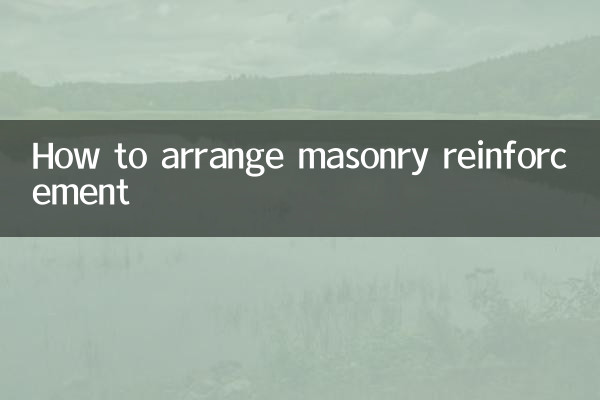How to arrange masonry reinforcement
In construction projects, the arrangement of masonry reinforcements is an important link in ensuring structural safety and stability. With the continuous development of construction technology, the layout methods of masonry reinforcement are also constantly optimized. This article will combine recent hot topics and hot content to introduce the layout method of masonry reinforcement in detail and provide structured data for reference.
1. Basic concepts of masonry reinforcement

Masonry reinforcement refers to the embedding of steel bars in masonry structures to improve their tensile, shear and seismic properties. The arrangement of reinforcement directly affects the overall performance of the structure, so it needs to be operated in strict accordance with the design specifications.
2. Arrangement method of masonry reinforcement
1.Horizontal reinforcement arrangement: Horizontal reinforcement is often used to increase the shear resistance of masonry. The steel bars should be arranged along the horizontal mortar joints of the masonry, and the spacing should not be too large.
2.Vertical reinforcement arrangement: Vertical reinforcement is mainly used to improve the compressive and seismic performance of masonry. Rebar should be inserted vertically into the masonry and effectively connected with horizontal reinforcement.
3.Mesh reinforcement arrangement: Mesh reinforcement is a crisscross arrangement of steel bars to form a grid structure, which is suitable for areas with high seismic resistance requirements.
3. Standard requirements for masonry reinforcement
| Project | Specification requirements |
|---|---|
| Steel bar diameter | It should not be less than 6mm and not more than 12mm |
| Rebar spacing | The horizontal reinforcement spacing should not be greater than 500mm, and the vertical reinforcement spacing should not be greater than 600mm. |
| Protective layer thickness | should not be less than 15mm |
| Reinforcement anchorage length | should not be less than 30 times the steel bar diameter |
4. Construction points of masonry reinforcement
1.Pre-embedded steel bars: Before masonry, the steel bars should be buried in place according to the design requirements to ensure accurate positioning.
2.Gray seam treatment: The mortar joints in the reinforced parts should be full to avoid cavities or grout leakage.
3.Connect nodes: The connection nodes between horizontal reinforcement and vertical reinforcement should be strong and can be welded or tied.
4.Quality check: During the construction process, the layout of steel bars should be checked regularly to ensure that it meets the design requirements.
5. The combination of recent hot topics and masonry reinforcement
Recently, hot topics in the construction industry have mainly focused on two aspects: green buildings and improvement of seismic performance. As an important means to improve structural performance, masonry reinforcement has also received widespread attention. The following is the combination of recent hot topics and masonry reinforcement:
| hot topics | Association with masonry reinforcement |
|---|---|
| green building | Optimize reinforcement layout, reduce material waste, and improve resource utilization |
| Seismic performance | Enhance the seismic resistance of masonry structures through mesh reinforcement arrangements |
| Intelligent construction | Use BIM technology to optimize reinforcement layout and improve construction accuracy |
6. Summary
The layout of masonry reinforcement is a key link in the construction of masonry structures and needs to be operated in strict accordance with the specifications. Through reasonable reinforcement arrangement, the overall performance of the structure can be effectively improved to meet the requirements of green building and seismic performance. I hope the content of this article can provide a reference for your engineering practice.

check the details

check the details